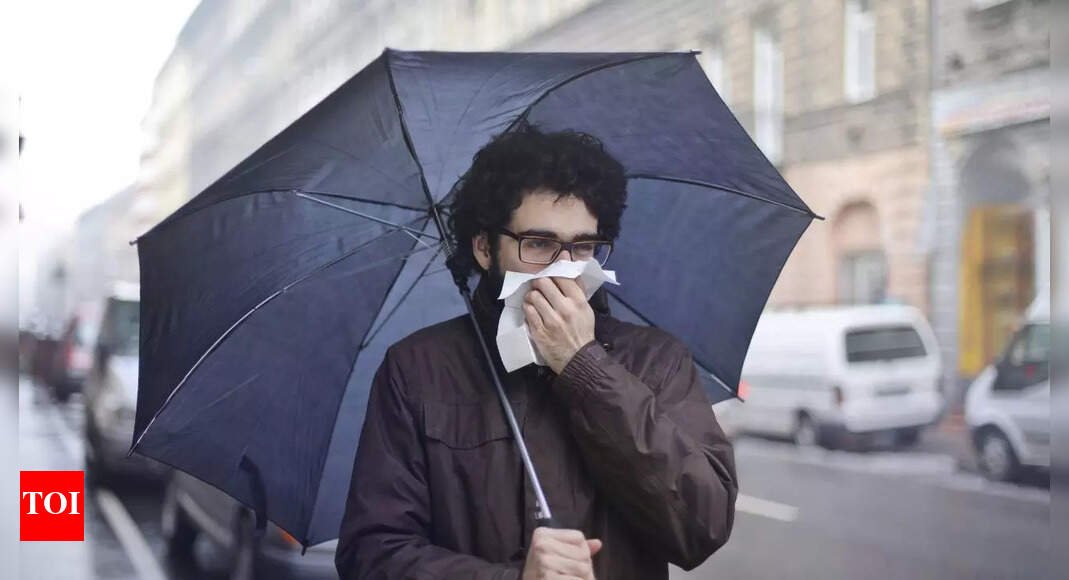The rainy season offers a refreshing break from the scorching summer, but it also brings a rise in illnesses due to damp conditions, stagnant water, and poor hygiene. These factors create the ideal breeding grounds for bacteria, viruses, and mosquitoes. From waterborne infections to mosquito-borne diseases, health risks multiply during this time. Increased humidity can also weaken the immune system, making people more vulnerable. Being aware of the most common seasonal illnesses can help with early detection and prevention. Below are ten common diseases to watch out for during the rainy season to ensure you and your family stay safe and healthy.
Diseases that surge during the rainy season: Symptoms and ways to stay safe
Common rainy season diseases, their symptoms and prevention
Dengue Fever
- Cause: Spread by Aedes mosquitoes that breed in stagnant water
- Symptoms: High fever, severe body pain, rashes, weakness
Dengue fever is a viral infection transmitted by a mosquito that thrives on standing water available during the monsoon. Sudden onset of high fever with intense body and joint pain are typically the first signs. Soon after, skin rashes and intense weakness develop. Immediate medical care and adequate hydration are needed to prevent developing complications of dengue hemorrhagic fever.
How to protect yourself:
- Remove standing water around the house (flowerpot, coolers, buckets).
- Employ mosquito repellants and use full-sleeved clothing.
- Sleep in bed nets against mosquitoes.
- Keep windows and doors screened or closed at dawn and dusk.
Malaria
- Cause: Transmitted by Anopheles mosquitoes due to Plasmodium parasites
- Symptoms: Chills, sweating, fever, vomiting
Malaria is another mosquito-borne disease that culminates in rainy seasons. The parasites are inoculated into the blood by bites from mosquitoes, and they create cyclical fever patterns accompanied by chills and vomiting. Precautionary measures like sleeping under a mosquito net, applying repellents, and keeping the place clean and free from standing water can reduce risk to a large degree.
How to protect yourself:
- Use insecticide-treated bed nets.
- Spray mosquito repellents indoors and outdoors.
- Stay indoors during peak mosquito hours.
- Maintain proper drainage to avoid mosquito breeding.
Leptospirosis
- Cause: Bacterial infection from water with animal urine
- Symptoms: Fever, muscle pain, red eyes
Leptospirosis occurs when you come into contact with urine-tainted water from infected animals, especially in floods. It produces flu-like symptoms like fever, body pain, and conjunctivitis (red eyes). Avoid wading through floodwaters, practice good hygiene, and consult a doctor if symptoms appear.
How to protect yourself:
- Do not walk through standing or contaminated water.
- Use protective footwear in heavy rain or cleaning.
- Practice hygiene and wash feet clean after exposure.
- Keep rodents out of your home and environment.
Chikungunya
- Cause: Viral infection transmitted by mosquitoes
- Symptoms: Fever, severe pain in the joints
Chikungunya is dengue-like but distinguished by prolonged arthritis-like joint pain. It is transmitted by the same mosquitoes that transmit dengue and most often causes acute fever with blinding joint inflammation. Rest, fluids, and pain control assuage symptoms in the absence of antiviral medication.
How to protect yourself:
- Prevent bites from mosquitoes through repellents and screens.
- Eliminate breeding sites such as uncovered water tanks.
- Wear arms and legs covers when stepping outside.
- Clean water storage vessels regularly.
Typhoid Fever
- Cause: Spread by contaminated food and water
- Symptoms: Prolonged fever, weakness, pain in the abdomen, constipation
Typhoid is a life-threatening bacterial infection that is common during monsoons due to poor sanitation. It causes prolonged high fever, abdominal pain, and gastrointestinal issues like constipation. Prevent typhoid by practicing food hygiene, drinking purified water, and taking the vaccine in risk-affected areas.
How to protect yourself:
- Drink only purified or boiled water.
- Avoid raw salads, street food, and unclean restaurants.
- Wash hands with soap thoroughly before eating.
- Vaccinate in exposed areas.
Cholera
- Cause: Eating contaminated food or water containing Vibrio cholerae bacteria
- Symptoms: Severe diarrhea, dehydration
Cholera is an acute diarrheal illness that can result in sudden dehydration and death if not treated. It usually results from water or food contaminated with the illness in dirty environments. Oral rehydration therapy promptly is crucial for recovery, alongside water safety and sanitation measures.
How to protect yourself:
- Drink only filtered, clean, or boiled water at all times.
- Keep yourself clean and dispose of waste safely.
- Wash hands often, particularly after using the toilet.
- Avoid consuming raw or undercooked food.
Hepatitis A
- Cause: Viral infection via contaminated water or food
- Symptoms: Jaundice, fatigue, nausea, pain in the abdomen
Hepatitis A is an infection of the liver caused primarily by drinking contaminated water or food. The symptoms include jaundice, weakness, and gastric disturbance. Vaccination and proper sanitation practices are the best ways to prevent infection.
How to protect yourself:
- Avoid consuming food from dirty food stalls or hawkers.
- Eat neatly cooked food and clean water.
- Wash vegetables and fruits thoroughly.
- Immunization is strongly advised in endemic areas.
Common Cold and Flu
- Cause: Viral infection caused by the temperature and humidity
- Symptoms: Sore throat, sneezing, cough, fever
Monsoon weather promotes the spread of respiratory viruses, and a greater number of people get colds and flu. The symptoms are typically mild but cause inconvenience. Rest, excessive fluid intake, and proper hygiene measures, including frequent hand washing, allow for rapid recovery.
How to protect yourself:
- Do not be in close contact with affected persons.
- Strengthen your immunity through a balanced diet and fluids.
- Cover mouth with tissues or the elbow while coughing/sneezing.
- Keep your environment clean and dry.
Fungal Infections
- Cause: Fungi that thrive in damp environments
- Symptoms: Itchy scaly lesions on skin; athlete’s foot; ringworm
The rainy season’s humid weather is an ideal environment for fungal skin and nail infections. Fungal infections like athlete’s foot and ringworm are common in this category. Keeping the skin dry, wearing loose clothing, and using antifungal creams or powder prevent and treat these infections.
How to protect yourself:
- Dry the skin and dress in breathable clothes.
- Immediately change out of wet clothing.
- Apply antifungal powders or creams if susceptible to infection.
- Avoid sharing towels, socks, or shoes.
Gastroenteritis
- Cause: Bacterial or viral infection through contaminated food or water
- Symptoms: Diarrhea, vomiting, stomach cramps
Gastroenteritis causes inflammation of the stomach and intestines and results in vomiting and diarrhea. It is usually picked up through unhygienic food preparation or drinking contaminated water. Proper food hygiene and hydration are needed to avoid the most serious complications.
How to protect yourself:
- All food must be freshly prepared and cooked.
- Don’t consume exposed food from street vendors.
- Keep food in clean, cover containers.
- Keep drinking water clean and don’t consume ice from unknown sources.
Also Read | Bryan Johnson’s routine reveals the future of healthy aging and live happily – know how he looks younger than his age
var _mfq = window._mfq || [];
_mfq.push([“setVariable”, “toi_titan”, window.location.href]);
!(function(f, b, e, v, n, t, s) {
function loadFBEvents(isFBCampaignActive) {
if (!isFBCampaignActive) {
return;
}
(function(f, b, e, v, n, t, s) {
if (f.fbq) return;
n = f.fbq = function() {
n.callMethod ? n.callMethod(…arguments) : n.queue.push(arguments);
};
if (!f._fbq) f._fbq = n;
n.push = n;
n.loaded = !0;
n.version = ‘2.0’;
n.queue = [];
t = b.createElement(e);
t.async = !0;
t.defer = !0;
t.src = v;
s = b.getElementsByTagName(e)[0];
s.parentNode.insertBefore(t, s);
})(f, b, e, ‘https://connect.facebook.net/en_US/fbevents.js’, n, t, s);
fbq(‘init’, ‘593671331875494’);
fbq(‘track’, ‘PageView’);
};
function loadGtagEvents(isGoogleCampaignActive) {
if (!isGoogleCampaignActive) {
return;
}
var id = document.getElementById(‘toi-plus-google-campaign’);
if (id) {
return;
}
(function(f, b, e, v, n, t, s) {
t = b.createElement(e);
t.async = !0;
t.defer = !0;
t.src = v;
t.id = ‘toi-plus-google-campaign’;
s = b.getElementsByTagName(e)[0];
s.parentNode.insertBefore(t, s);
})(f, b, e, ‘https://www.googletagmanager.com/gtag/js?id=AW-877820074’, n, t, s);
};
function loadSurvicateJs(allowedSurvicateSections = []){
const section = window.location.pathname.split(‘/’)[1]
const isHomePageAllowed = window.location.pathname === ‘/’ && allowedSurvicateSections.includes(‘homepage’)
const ifAllowedOnAllPages = allowedSurvicateSections && allowedSurvicateSections.includes(‘all’);
if(allowedSurvicateSections.includes(section) || isHomePageAllowed || ifAllowedOnAllPages){
(function(w) {
function setAttributes() {
var prime_user_status = window.isPrime ? ‘paid’ : ‘free’ ;
var geoLocation = window?.geoinfo?.CountryCode ? window?.geoinfo?.CountryCode : ‘IN’ ;
w._sva.setVisitorTraits({
toi_user_subscription_status : prime_user_status,
toi_user_geolocation : geoLocation
});
}
if (w._sva && w._sva.setVisitorTraits) {
setAttributes();
} else {
w.addEventListener(“SurvicateReady”, setAttributes);
}
var s = document.createElement(‘script’);
s.src=”https://survey.survicate.com/workspaces/0be6ae9845d14a7c8ff08a7a00bd9b21/web_surveys.js”;
s.async = true;
var e = document.getElementsByTagName(‘script’)[0];
e.parentNode.insertBefore(s, e);
})(window);
}
}
window.TimesApps = window.TimesApps || {};
var TimesApps = window.TimesApps;
TimesApps.toiPlusEvents = function(config) {
var isConfigAvailable = “toiplus_site_settings” in f && “isFBCampaignActive” in f.toiplus_site_settings && “isGoogleCampaignActive” in f.toiplus_site_settings;
var isPrimeUser = window.isPrime;
var isPrimeUserLayout = window.isPrimeUserLayout;
if (isConfigAvailable && !isPrimeUser) {
loadGtagEvents(f.toiplus_site_settings.isGoogleCampaignActive);
loadFBEvents(f.toiplus_site_settings.isFBCampaignActive);
loadSurvicateJs(f.toiplus_site_settings.allowedSurvicateSections);
} else {
var JarvisUrl=”https://jarvis.indiatimes.com/v1/feeds/toi_plus/site_settings/643526e21443833f0c454615?db_env=published”;
window.getFromClient(JarvisUrl, function(config){
if (config) {
const allowedSectionSuricate = (isPrimeUserLayout) ? config?.allowedSurvicatePrimeSections : config?.allowedSurvicateSections
loadGtagEvents(config?.isGoogleCampaignActive);
loadFBEvents(config?.isFBCampaignActive);
loadSurvicateJs(allowedSectionSuricate);
}
})
}
};
})(
window,
document,
‘script’,
);
#common #monsoon #diseases #health #problems #symptoms #protect



